StRAB4 gene is required for filamentous growth, conidial development, and pathogenicity in Setosphaeria turcica
- PMID: 38264490
- PMCID: PMC10804457
- DOI: 10.3389/fmicb.2023.1302081
StRAB4 gene is required for filamentous growth, conidial development, and pathogenicity in Setosphaeria turcica
Abstract
Setosphaeria turcica, the fungal pathogen responsible for northern corn leaf blight in maize, forms specialized infectious structures called appressoria that are critical for fungal penetration of maize epidermal cells. The Rab family of proteins play a crucial role in the growth, development, and pathogenesis of many eukaryotic species. Rab4, in particular, is a key regulator of endocytosis and vesicle trafficking, essential for filamentous growth and successful infection by other fungal pathogens. In this study, we silenced StRAB4 in S. turcica to gain a better understanding the function of Rab4 in this plant pathogen. Phenotypically, the mutants exhibited a reduced growth rate, a significant decline in conidia production, and an abnormal conidial morphology. These phenotypes indicate that StRab4 plays an instrumental role in regulating mycelial growth and conidial development in S. turcica. Further investigations revealed that StRab4 is a positive regulator of cell wall integrity and melanin secretion. Functional enrichment analysis of differentially expressed genes highlighted primary enrichments in peroxisome pathways, oxidoreductase and catalytic activities, membrane components, and cell wall organization processes. Collectively, our findings emphasize the significant role of StRab4 in S. turcica infection and pathogenicity in maize and provide valuable insights into fungal behavior and disease mechanisms.
Keywords: RNA sequencing; Setosphaeria turcica; StRAB4 gene; conidia; gene silencing; infection ability.
Copyright © 2024 Li, Zhu, Wang, Zeng, Jia, Feng, Han, Shen, Wang, Hao and Dong.
Conflict of interest statement
The authors declare that the research was conducted in the absence of any commercial or financial relationships that could be construed as a potential conflict of interest.
Figures
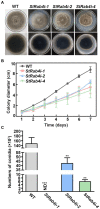
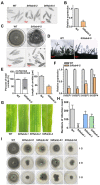
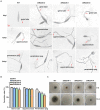
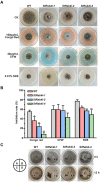
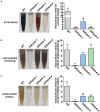
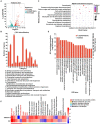


Similar articles
-
The Septin Gene StSep4 Contributes to the Pathogenicity of Setosphaeria turcica by Regulating the Morphology, Cell Wall Integrity, and Pathogenic Factor Biosynthesis.J Agric Food Chem. 2023 Dec 13;71(49):19568-19580. doi: 10.1021/acs.jafc.3c06635. Epub 2023 Nov 29. J Agric Food Chem. 2023. PMID: 38019936
-
The serine palmitoyltransferase core subunit StLcb2 regulates sphingolipid metabolism and promotes Setosphaeria turcica pathogenicity by modulating appressorium development.Int J Biol Macromol. 2024 Dec;283(Pt 3):137928. doi: 10.1016/j.ijbiomac.2024.137928. Epub 2024 Nov 22. Int J Biol Macromol. 2024. PMID: 39579824
-
The catalytic subunit of type 2A protein phosphatase negatively regulates conidiation and melanin biosynthesis in Setosphaeria turcica.Int J Biol Macromol. 2024 May;266(Pt 2):131149. doi: 10.1016/j.ijbiomac.2024.131149. Epub 2024 Mar 29. Int J Biol Macromol. 2024. PMID: 38556232
-
Genetics of Resistance and Pathogenicity in the Maize/Setosphaeria turcica Pathosystem and Implications for Breeding.Front Plant Sci. 2017 Aug 29;8:1490. doi: 10.3389/fpls.2017.01490. eCollection 2017. Front Plant Sci. 2017. PMID: 28900437 Free PMC article. Review.
-
Recent advances in the population biology and management of maize foliar fungal pathogens Exserohilum turcicum, Cercospora zeina and Bipolaris maydis in Africa.Front Plant Sci. 2024 Aug 1;15:1404483. doi: 10.3389/fpls.2024.1404483. eCollection 2024. Front Plant Sci. 2024. PMID: 39148617 Free PMC article. Review.
References
-
- Arya G. C., Srivastava D. A., Pandaranayaka E. P. J., Manasherova E., Prusky D. B., Elad Y., et al. . (2020). Characterization of the role of a non-GPCR membrane-bound CFEM protein in the pathogenicity and germination of Botrytis cinerea. Microorganisms 8:1043. doi: 10.3390/microorganisms8071043, PMID: - DOI - PMC - PubMed
LinkOut - more resources
Full Text Sources

